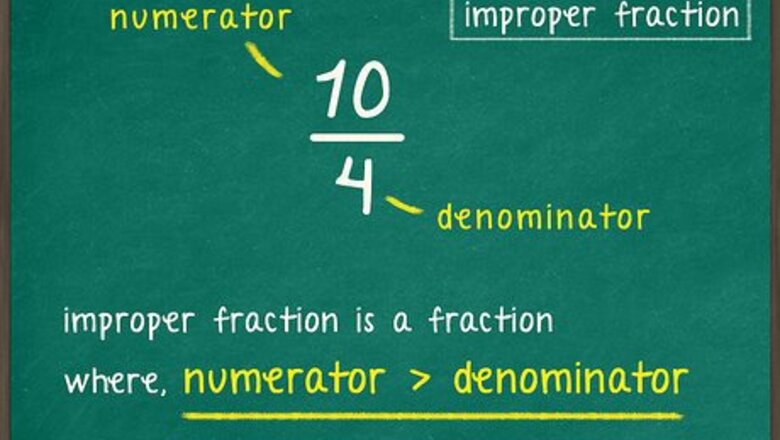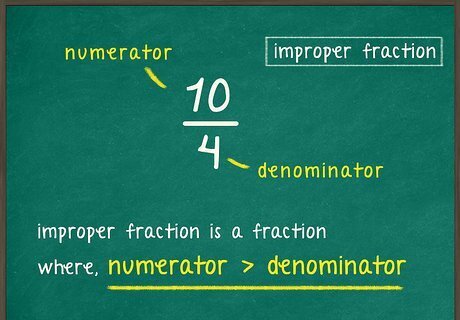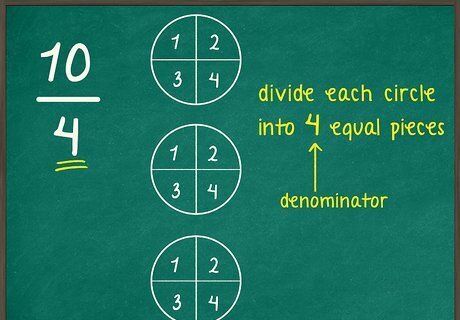
views
X
Research source
so it is helpful to know how to create them.
Using a Model

Determine whether your fraction is improper. An improper fraction is a fraction that has a larger numerator than denominator. For example, 10 4 {\displaystyle {\frac {10}{4}}} {\frac {10}{4}} is an improper fraction, because ten is greater than 4.

Interpret the denominator. The denominator is the number below the fraction bar. It tells you how many equal pieces a whole is divided into. For example, in the fraction 10 4 {\displaystyle {\frac {10}{4}}} {\frac {10}{4}}, 4 is the denominator, and it tells you that a whole is divided into four equal parts, or quarters.
Interpret the numerator. The numerator is the number above the fraction bar. It tells you how many pieces you have. For example, in the fraction 10 4 {\displaystyle {\frac {10}{4}}} {\frac {10}{4}}, 10 is the numerator, and it tells you that you have 10 parts, or 10 quarters.

Draw circles to represent the whole. Divide each whole according to the denominator of your fraction. For example, if your denominator is 4, then divide each circle you draw into 4 equal pieces, or quarters.
Shade in pieces according to your numerator. The number in the numerator tells you how many pieces you should shade in. For example, if your fraction is 10 4 {\displaystyle {\frac {10}{4}}} {\frac {10}{4}}, you will shade in 10 quarters.
Count how many whole circles you shaded in. To simplify an improper fraction, you must turn it into a mixed number, which includes a whole number and a fraction together. The number of whole circles you shaded in represents the whole number of your mixed fraction. Write this number down. For example, for the fraction 10 4 {\displaystyle {\frac {10}{4}}} {\frac {10}{4}}, you should have shaded in 2 whole circles, so the whole number of your mixed number will be 2.
Count how many parts of a whole you shaded in. The leftover shaded parts will represent the fraction in your mixed number. Write this fraction next to your whole number, and you have your mixed number. For the fraction 10 4 {\displaystyle {\frac {10}{4}}} {\frac {10}{4}}, you should have shaded in 2 4 {\displaystyle {\frac {2}{4}}} {\frac {2}{4}} of a circle, so the fraction part of your mixed number will be 2 4 {\displaystyle {\frac {2}{4}}} {\frac {2}{4}}. So 10 4 {\displaystyle {\frac {10}{4}}} {\frac {10}{4}} is equal to 2 2 4 {\displaystyle 2{\frac {2}{4}}} 2{\frac {2}{4}}.
Simplify your answer, if necessary. Sometimes the fraction of your mixed number will need to be reduced before you reach your final, simplified answer. For example, if your mixed number is 2 2 4 {\displaystyle 2{\frac {2}{4}}} 2{\frac {2}{4}}, you could simplify it to 2 1 2 {\displaystyle 2{\frac {1}{2}}} 2{\frac {1}{2}}
Using Division
Determine whether your fraction is improper. An improper fraction is a fraction that has a larger numerator than denominator. For example, 10 4 {\displaystyle {\frac {10}{4}}} {\frac {10}{4}} is an improper fraction, because 10 > 4 {\displaystyle 10>4} 10>4.
Divide the numerator by the denominator. Remember that the fraction bar can be interpreted as a division symbol. To simplify an improper fraction, you must turn it into a mixed number, which includes a whole number and a fraction together. The number of times you can divide the numerator evenly by the denominator will be the whole number of your mixed number. Write this number down, and note the remainder. The denominator will not divide evenly into the numerator. The remainder will be interpreted as the fraction part of your mixed number. For example, for the fraction 10 4 {\displaystyle {\frac {10}{4}}} {\frac {10}{4}} complete the calculation 10 ÷ 4 = 2 R 2 {\displaystyle 10\div 4=2R2} 10\div 4=2R2. So the whole number of your fraction will be 2 {\displaystyle 2} 2.
Turn the remainder into a fraction. To do this, take the remainder, and place it over the denominator of the original improper fraction. Combine this new fraction with the whole number, and you have your mixed number. For example, 10 ÷ 4 = 2 R 2 {\displaystyle 10\div 4=2R2} 10\div 4=2R2, so the fraction would be 2 4 {\displaystyle {\frac {2}{4}}} {\frac {2}{4}}. So 10 4 {\displaystyle {\frac {10}{4}}} {\frac {10}{4}} is equal to 2 2 4 {\displaystyle 2{\frac {2}{4}}} 2{\frac {2}{4}}.
Simplify your answer, if necessary. Sometimes the fraction of your mixed number will need to be reduced before you reach your final, simplified answer. Divide the numerator and denominator of the fraction by their greatest common factor. For example, if your mixed number is 2 2 4 {\displaystyle 2{\frac {2}{4}}} 2{\frac {2}{4}}, you could simplify it to 2 1 2 {\displaystyle 2{\frac {1}{2}}} 2{\frac {1}{2}}. EXPERT TIP Joseph Meyer Joseph Meyer Math Teacher Joseph Meyer is a High School Math Teacher based in Pittsburgh, Pennsylvania. He is an educator at City Charter High School, where he has been teaching for over 7 years. Joseph is also the founder of Sandbox Math, an online learning community dedicated to helping students succeed in Algebra. His site is set apart by its focus on fostering genuine comprehension through step-by-step understanding (instead of just getting the correct final answer), enabling learners to identify and overcome misunderstandings and confidently take on any test they face. He received his MA in Physics from Case Western Reserve University and his BA in Physics from Baldwin Wallace University. Joseph Meyer Joseph Meyer Math Teacher To simplify fractions, you can divide both the numerator and denominator by a common factor. This creates a new, easier-to-use fraction with smaller components, but it represents the same value. For instance, if you divide both the numerator and denominator of 6/12 by 2, you get 3/6, which is equal to 1/2.

















Comments
0 comment